Article originally published in the 23rd issue of the Discover History magazine.
Although one and the other ruled over territories much smaller than the current England and Spain and were not called that, Alfred of Wessex and Alfonso III of Asturias are two monarchs of capital importance in English and Spanish medieval history respectively. In fact, this is the reason for the first historical parallelism between the two kings:Alfredo is known by the nickname of the Great, while Alfonso III is called the Great. But the coincidences between one and the other are not limited to this symbolic issue, but also reach other very significant aspects.
1.- Historical period. Alfonso III reigned for more years and even later (866-910) than Alfredo (871-899), but both monarchs were contemporary and carried out their most significant historical events at the same historical moment, the 870s and 880s. , there is no evidence that they got to know each other or correspond, although possibly they must have been aware of each other's existence, since they kept informed of what was happening beyond the borders of their kingdom.
2.- Difficulties to access the throne.
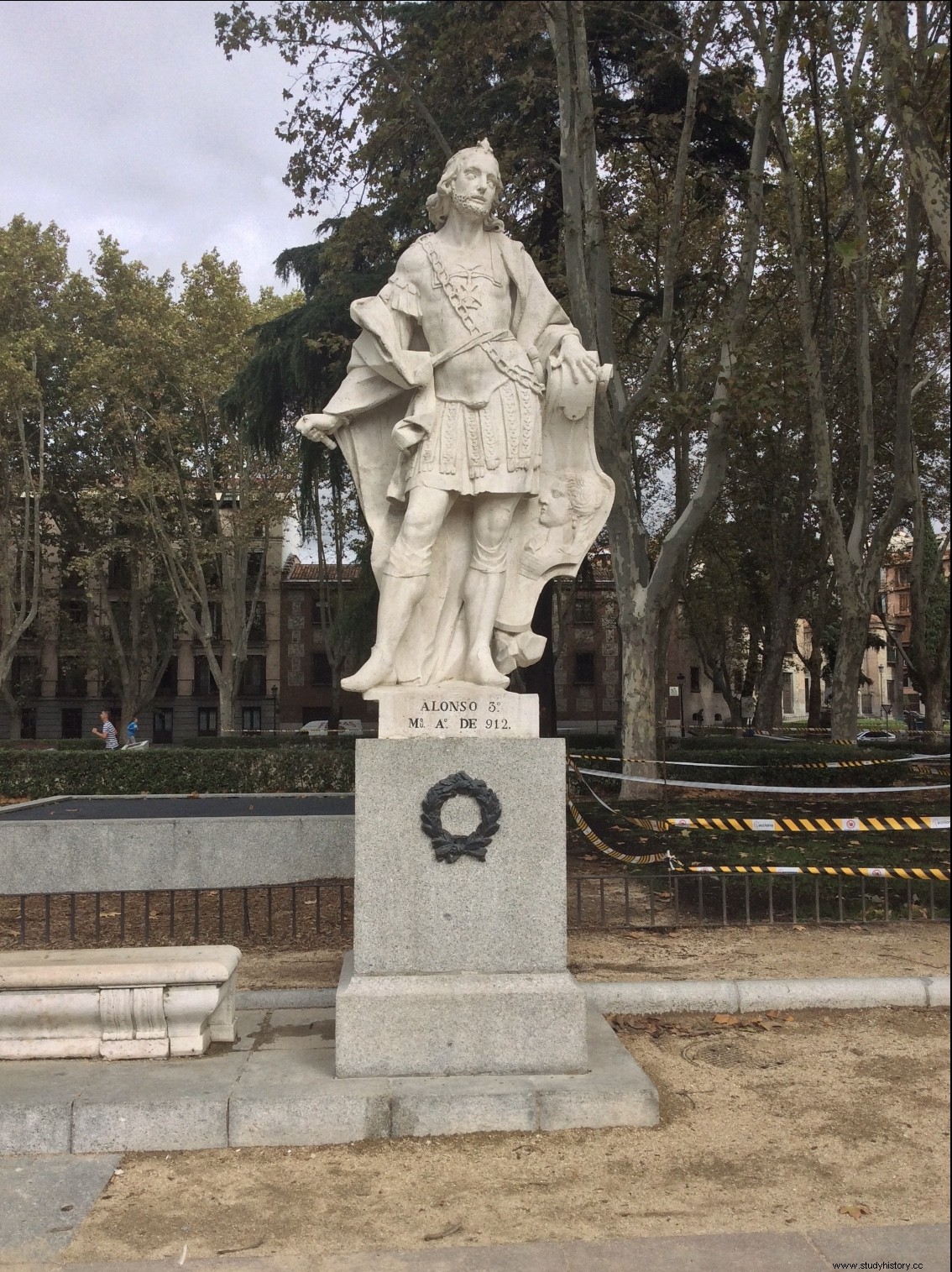
– When the King of Asturias Ordoño I passed away, his eldest son, Alfonso, was eighteen years old and had government experience, since he had collaborated with his father, possibly through the formula of association to the throne to take charge of Galicia, since he was fourteen. That did not prevent a nobleman named Fruela Bermúdez, Count of Lugo and of Galician origin, from trying to dethrone him and gird the crown. Alfonso was forced to take refuge in Castile, dominated by Count Rodrigo, a firm supporter of his. According to some sources, Rodrigo accompanied the king to Asturias to confront the rebellion, while others suggest that the Asturian nobles themselves took care of disrupting Fruela's maneuver and Alfonso was able to return and sit on the throne. The traitor was executed.
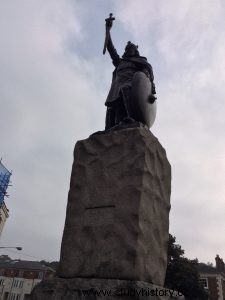
– In Alfredo's case the situation was something more complex, because in the Saxon monarchies the crown was not automatically inherited from father to son, but was a council of notables, the witanegamot , the one who chose the successor of the deceased king. Although sometimes it was the son of the deceased monarch who was elected, it was not always so. This circumstance played in Alfred's favour, because when his brother King Aethelred died in 871 the crown may have passed to the deceased's son, Aethelwold. However, Wessex was going through a very delicate situation, with furious Viking attacks that endangered its very existence. That is why the council decided to put the crown in the hands of Alfred, who had already fought with the invaders and had extensive experience and training in government tasks, instead of handing over power to the adolescent and inexperienced Aethelwold.
3.- Confrontations against a non-Christian enemy.
– When Alfonso III came to the throne in 866, the Iberian Peninsula had been under Muslim rule for more than a century and a half after the invasion in 711 and the defeat of the last Visigothic monarch Rodrigo in the battle of Guadalete. Shortly after, Christian resistance centers arose in different parts of the north of ancient Hispania, which in the following decades were conquering more and more territory from the Arabs, followers of the newly born and thriving Mohammedan religion. In the following map you can see the situation in the year 850, shortly before the accession to the throne of Alfonso III, compared to the situation in the year 930, a little after his death.
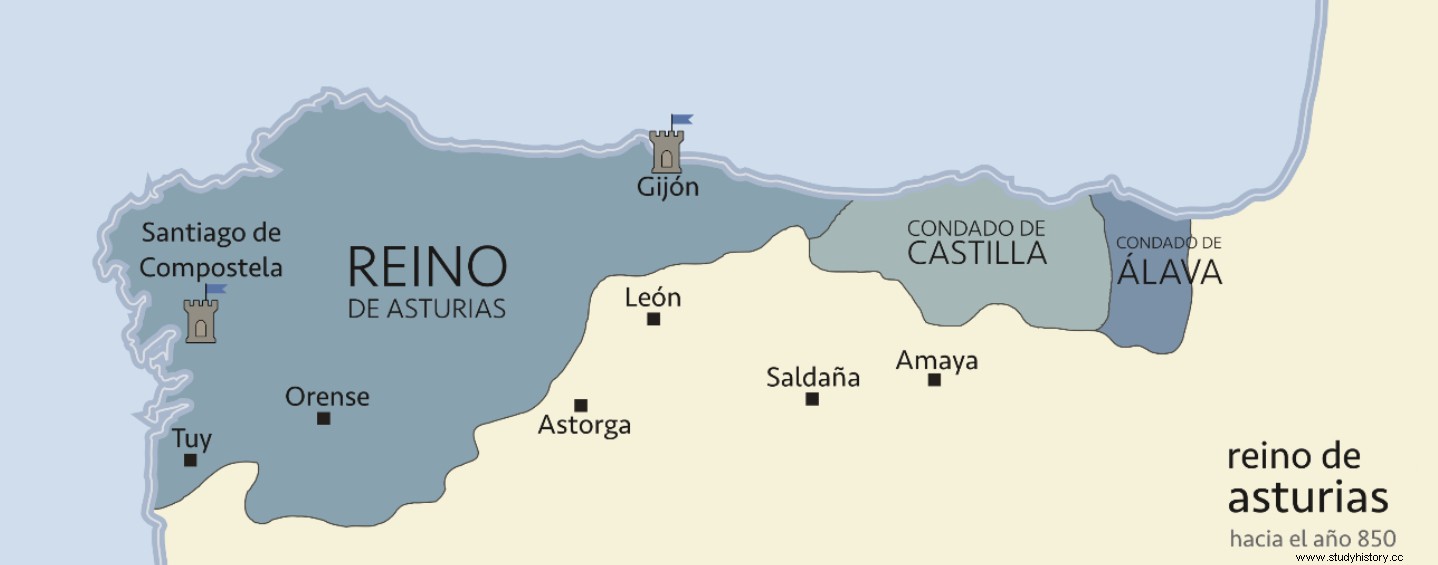
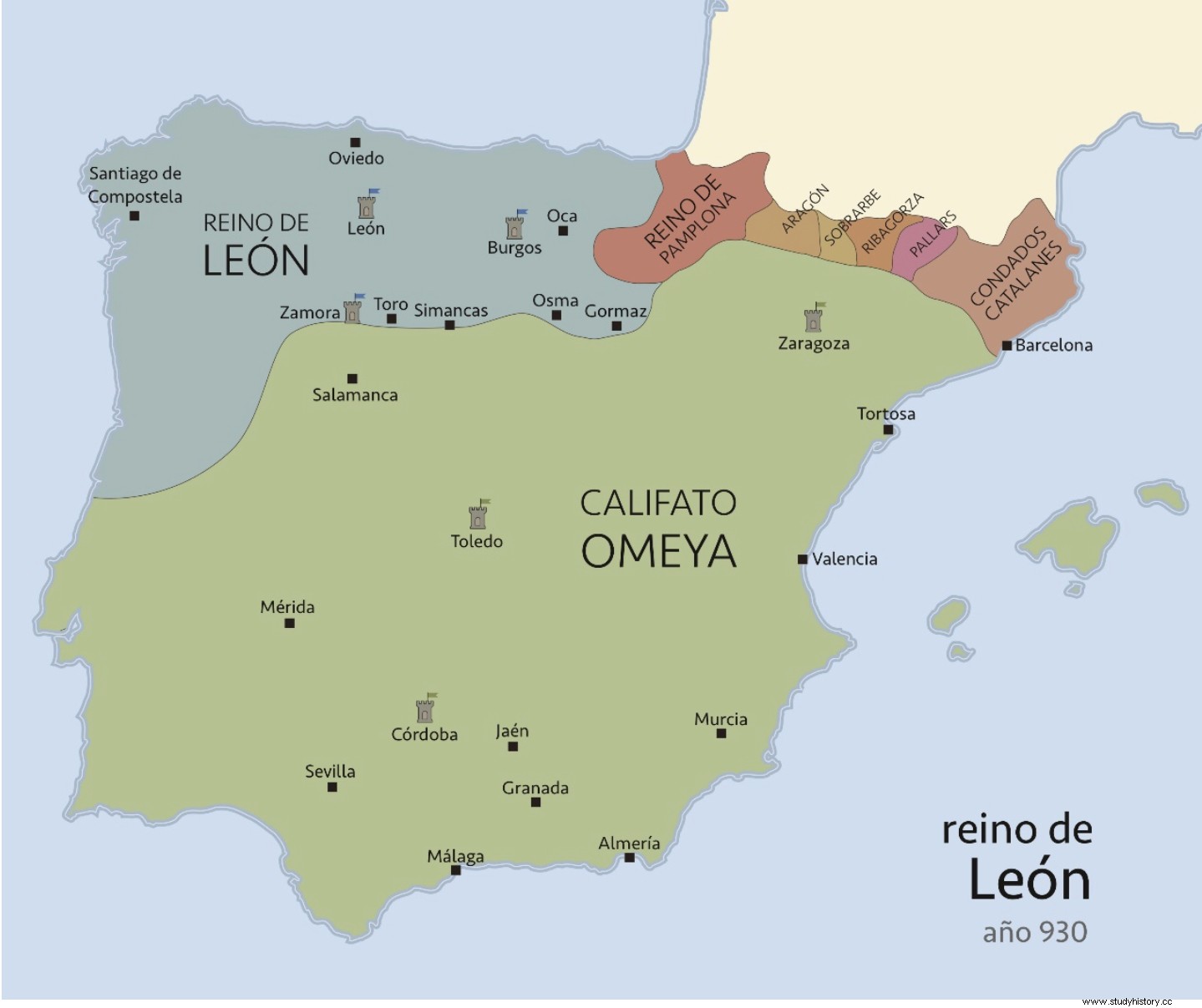
– As regards England, since In the year 790 it had been subjected to attacks by the Vikings from Scandinavia, mainly from Denmark. The Vikings were pagans, worshiping gods not unlike those the Saxons had revered when they themselves invaded England in the fifth century, before converting to Christianity. These expeditions, which initially aimed at looting and robbery, gradually became a full-fledged invasion with the aim of conquering and settling on the British Isle. In the year 866 York had fallen into Danish hands and before long three of the four Saxon kingdoms that existed in the second half of the 9th century (Northumbria, Mercia and East Anglia) had been defeated and only Wessex held out. The area dominated by the invaders was known as Danelaw and threatened to destroy the last Saxon kingdom and extend its rule to the rest of the island.
4.- Military victories . The reigns of both Alfonso III and Alfred of Wessex were marked by significant triumphs in battles of great importance and consequences, in part magnified by the propaganda in which both were experts, as will be seen later.
– Alfonso III significantly expanded the area of the kingdom of Asturias and conquered important places such as Porto, Coyanza (Valencia de Don Juan), Sahagún, Braga, Coimbra, Cea and Guimaraes. In the year 878, the emir Mohamed I sent two large armies against Alfonso's territory in the traditional pincer maneuver consisting of advancing one from the east and the other from the west. The eastern army devoted itself essentially to looting and looting in the domains of the Banu Qasi in Zaragoza and Tudela, reaching Pamplona according to some sources.
But the emir's main objective was the Asturian kingdom and to do so, in a maneuver that was not the first time used by the Muslims, he divided the western army into two forces. One of them went to León and the second advanced towards Coimbra. Alfonso decided to focus on the Muslim wing that was advancing towards León.
Both armies met near Benavente, in a place known as La Polvoraria or Polvorosa. There, the Asturians won a resounding victory over the Cordovans. Some source puts the Arab casualties at thirteen thousand. Not content with this, Alfonso III set out to face the other Muslim contingent, whom he also defeated in Valdemora, about fifteen kilometers from the current town of Valencia de Don Juan (then Castillo de Coyanza).
Later, in the year 901, a call to holy war by a Muslim leader, Abu Ali al-Sarray, caused an army of about sixty thousand men, al under the command of an Umayyad prince named Ahmad ibn Muawiya, launched himself against Zamora. Alfonso III led the Christian forces to face the threat and, after several days of combat that seemed favorable to the Arabs, the king decided to surround the Muslim camp at night and achieved victory in what was known as the Day of the Moat of Zamora. .
– For his part, Alfred, after a difficult start to his reign in which he was forced to take refuge in the Somerset marshes, began to regain ground and not only conquered Wessex, but took over part of the territory that had belonged to Mercia, including the city of London, conquered by blood and fire. He had already participated in a Saxon victory at Ashdown (871) when his brother was still reigning and managed to prevail in the decisive battle of Edington against the Danish army led by Guthrum, curiously in 878, the same year that Alfonso achieved the first two victories we have seen. reviewed.
Later, in 896, a force of about 4,000 warriors from Denmark invaded eastern Kent, led by a chieftain named Haesten. Their families traveled with them, which made it clear that their intention was to settle in the area. Although Alfred managed to drive them back, he was suddenly faced with a chain of coordinated Danelaw Norse attacks on the western part of his domain that were intended to focus the Saxons on repelling this threat in western Wessex, so that the newcomers could settle in the east of the kingdom.
But the Danes underestimated Alfred and the military preparation of his army. In the following months, the Wessex were not only able to defeat the invaders who had penetrated from the west, but also managed to send reinforcements to the eastern part of the kingdom, so that finally the Norsemen from the Danelaw gave up. their attacks in the west, while the new wave from Denmark left Kent and ended up settling in the domains of their compatriots in East Anglia and Northumbria.
5.- Pacts with the enemy. Both Alfredo and Alfonso were masters of the carrot-and-stick policy, alternating the military campaigns outlined above with peace negotiations that allowed them to settle in his government and consolidate its defenses.
– After his victories in the year 878, Alfonso III got the emir of Córdoba to sign a three-year truce, which he did not waste, as will be seen later. As the end of the three-year truce period agreed with Alfonso III approached, the situation in the Emirate of Cordoba did not seem very promising for the Muslims, with various internal rebellions in Mérida, Ronda and Toledo. To finish fixing the situation, a maritime attack organized by Córdoba on Galicia ended in resounding failure when the fleet was destroyed by a storm.
All these circumstances made more and more Mozarabs look with hope to the kingdom of Asturias and decide to emigrate to Christian territory, founding or restoring various monasteries (Samos, Sahagun, San Miguel de la Escalada). The emirate had to act against the Asturian threat and it was ordered to do so in the years 882 and 883.
In the year 882, the emirate's troops entered the Kingdom of Asturias through Castile and sacked the area while on their way to León. Alfonso III had a large army to confront the Muslims, but he preferred to avoid a fight in the open field. The Muslims continued with his aceifa for a time, but finally they agreed to peace in Castro Alcoba, where the exchange of hostages and the delivery of various gifts to the Asturian king (relics of saints and bibles) were also agreed.
The situation was repeated almost exactly the following year:Muslim aceifa with looting and destruction of some squares, Alfonso III avoiding a direct clash and finally peace, although this time without exchange of hostages or gifts.
With this the Cordovan campaigns against Asturias ended for a time, not only because of the conviction of their uselessness, but also because of the multiplication of internal problems in the emirate.
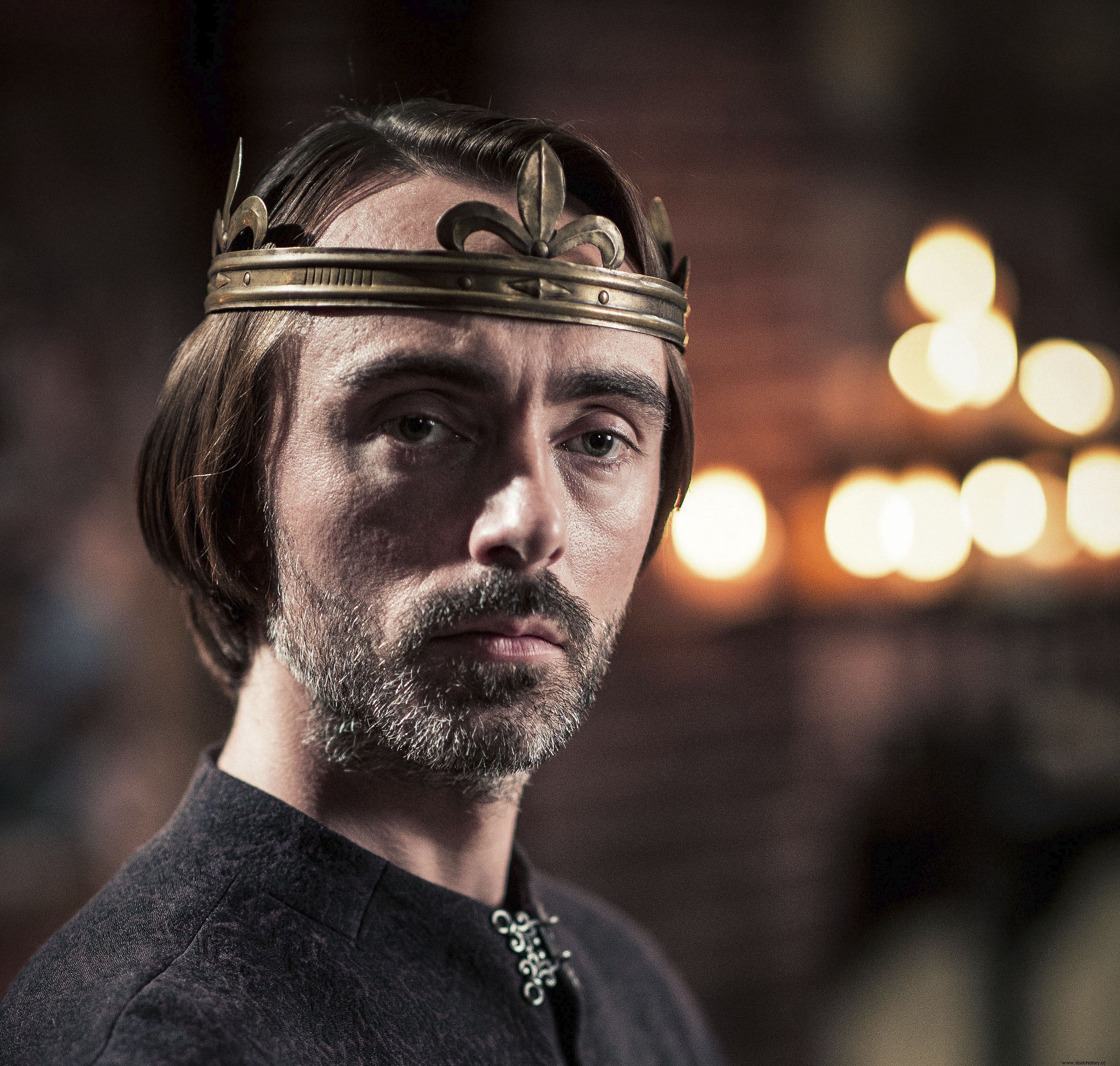
– At the battle of Edington Alfred's forces they had surprised the Danes, but were clearly insufficient for a long campaign to recapture all the ground conquered by the invaders. It was time to sign peace with Guthrum, who converted to Christianity adopting the name of Athelstan; Alfredo was his godfather.
The Danes left Wessex and settled in East Anglia, where Guthrum was proclaimed king. Later it was agreed to set the border between the Danish kingdom of Guthrum and the Anglo-Saxon kingdom of Alfredo, who not only recovered the territory of Wessex but also incorporated into his kingdom areas that previously did not belong to it but to Mercia.
In all likelihood, Alfred also had to give Guthrum a more than generous amount of money to get him to agree to the deal. However, from the Saxon point of view, the acceptance of this gift, coupled with the choice of the symbolic name Athelstan and Alfred's sponsorship of Guthrum's baptism, made Guthrum and his kingdom subjects of the King of Wessex, who he would hold a position of supremacy as sovereign lord of the kingdom of East Anglia.
Whether Guthrum and the Danes understood it this way too is another question. For the Scandinavian, the decision was probably more practical than anything else:if he was going to rule a kingdom populated mainly by Christian Saxons, it was convenient that he at least formally appear to be both, and for this it helped to be baptized and adopt a Saxon name.
In any case, the agreement between Alfredo and Guthrum/Athelstan worked for a while. In the year 879 a fleet from Denmark sailed up the Thames to London, where it remained for a few months. The Saxons feared that Guthrum's army would join them, but it did not. Ultimately, the invading fleet left Britain for France and the Netherlands.
We still have a few historical parallels between these two contemporary monarchs, but we will leave them for the second and last entry in this series.
Fernández de Lis, D. (2019) From Covadonga to Tamarón. The history of the Asturian-Leonese monarchy from Pelayo to Vermudo III.
Cádiz Álvarez, J. C. (2017) Prehistory. ancient Asturias. The kingdom of Asturias. Its consolidation. Nobel Editions.
Fernández Conde, F. J. (2015). Studies on the Asturian monarchy. Gijon. Trea S.L Editions
Fernández Conde, F. J., Gutiérrez González, A., Fernández Mier, M., Suárez Álvarez, M. J., Arias Páramo, L. (2009). Social and political powers in Asturias. 8th-10th centuries. Territory, society and power. Journal of Medieval Studies. Annex No. 2
Ladero Quesada, M. Á. (2014). The medieval formation of Spain . Madrid. Publisher Alliance. 2nd edition.
Manzano Moreno, E. (2015). History of Spain. Medieval Times, Volume 2. Madrid. Criticism. Editorial Marcial Pons
Gordo Molina, Á. and Melo Carrasco, D. (Coord.) (2017). The Peninsular Middle Ages, approaches and problems . Gijon. Ediciones Trea, S. L
García de Castro Valdés, C. and Ríos González, S. (1997). History of Asturias. Medieval Asturias l. Gijon. Editions TREA S. L
Campomanes Calleja, E. (2004). Asturias:from kingdom to principality. Gijon. Editorial Picu Urriellu
Álvarez Palenzuela, V. Á. (Coord). (2017). History of Spain in the Middle Ages . Ariel. 7th impression.
Chao Prieto, R. History of the kings of León . Rimpego editorial
Fernández Catón, J. M.ª. (2007). Monarchy and society in the kingdom of León, from Alfonso III to Alfonso VII. Lion. Center for Studies and Research San Isidoro
Carvajal Castro, Á. (2017). Under the Regnum mask:the Asturian-Leonese monarchy in León (854-1037). Madrid. Editorial CSIC.
Martínez Díez, G. (2005). The county of Castile (711-1038). History versus legend (I and II) Marcial Pons Editions of History.
Williams, T. (2017). Viking Britain. An Exploration . London. HarpersCollins Publishers
Domínguez González, C. (2015) Anglo-Saxon England. A historical synthesis (ss. V-XI). Madrid. La Ergastula Editions.
